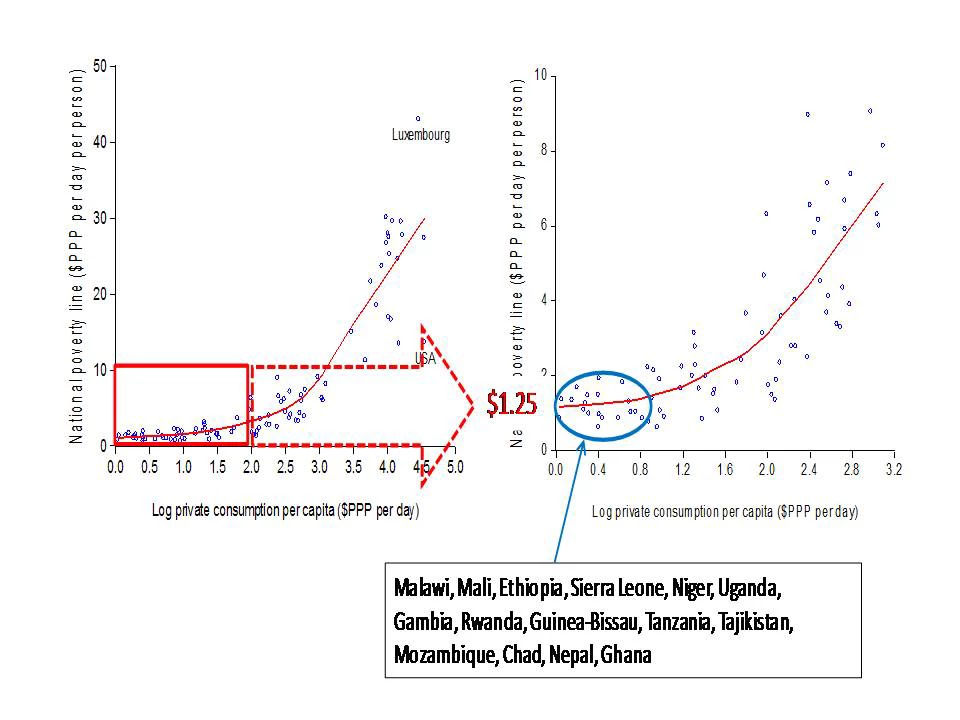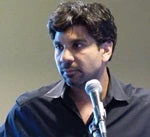(based on discussions with Chico Ferreira, Ambar Narayan, Carolina Sanchez and especially, Aaditya Mattoo)
This is part I of a three-part series.
Spurred by a renewed focus on eradicating poverty, many discussions at the World Bank are around `targets’ for poverty reduction. Martin Ravallion recently presented his proposal at our development seminar. The talk had 2 parts. The first part proposed a “global” poverty line(s) to set targets; the main innovation here over the WB standard of “you are poor if you live on less than $1.25 per day” is the proposal of a new relative notion of poverty. The second part forecasted poverty declines and proposed `reasonable’ and `ambitious’ targets for global institutions under different scenarios.
There are three parts to this summary: (A) What is being proposed; (B) What does this imply and (C) What questions does this raise.
Caveat Lector
1. I am not an expert on poverty measurement, which is why this is a neophyte’s guide!
2. This post does not cover the use of price indices and the PPP approach; this was not discussed at the seminar.
3. I also don’t weigh into discussions regarding the usefulness of summary statistics like the poverty head-count, instead of relying on the full distribution of incomes.
Part 1: What is Martin Proposing?
Martin’s proposal tries to count the number of poor in the world at any given point in time. Why do this? The argument is that such an estimate (and the monitoring of these numbers over time) will allow for greater momentum among international institutions to eradicate poverty, much as the Millennium Development Goals tried to do earlier. There were two options discussed: Absolute Poverty and Relative Poverty.
Absolute Poverty: The World Bank historically used a global number of $1 per day, now updated to $1.25 a day, to count the number of poor people in the world. Using this "global poverty line" Martin showed that global poverty has declined sharply and the pace of decline has accelerated after 1990. For those obsessed with the US financial crisis, the memorable line was that "we cannot detect any effect of the Lehmann brother's crisis on global poverty decline, apart from a short-lived blip". Martin discussed whether the decline would continue (important for forecasting) and suggested that once countries hit poverty rates below 10%, the decline slows down.
Relative Poverty: Then, Martin suggests that the absolute poverty line is misleading because people spend money on goods and services that serve a social inclusion value and this directly affects their welfare (in Yemen they spend on Qat (a mild narcotic), in South Asia on weddings etc.).
Concept: The alternate to the absolute poverty approach is a relative poverty approach, where utility, U(.) depends on the mean or median of incomes in your country, Y/M. Martin then argues convincingly that both your own income and your relative income must enter the utility function, so that U=U(Y,Y/M). At very low levels of income, there should be an absolute poverty line, but as incomes go up, the relative poverty line kicks in. This “global relative poverty line” is constant at around $1.25 at low levels of income, but then increases with country income as countries get richer.
Data and Fitting: To assess the "inflexion" point in this global relative poverty line, Martin uses data on national poverty lines. The picture he presented (below) graphs national poverty lines on log private consumption, where every point represents a country’s poverty line (Y-axis) and income (X-axis). As is clear, the way that countries make their choices over who is poor conforms quite closely to the idea that at very low levels of poverty, its absolute poverty that matters, but as countries get richer, relative notions of poverty kick-in.
Estimates: Martin then fits this line using econometric fitting techniques. Using this new global poverty line, he counts the number of poor people for each country and sums these up to arrive at the new relatively global poor. The conclusion is that even as absolute poverty has declined, relative poverty has
(A) remained higher (at about 40% of the population) and (B) has been slow to come down. Based on these computations, Martin presented various forecasts of realistic and ambitious targets that could be achieved under assumptions on growth and inequality.



Join the Conversation